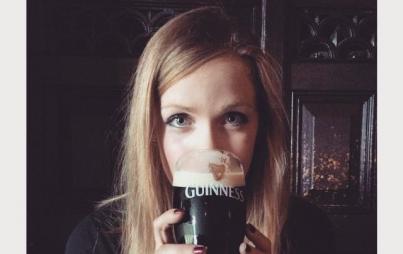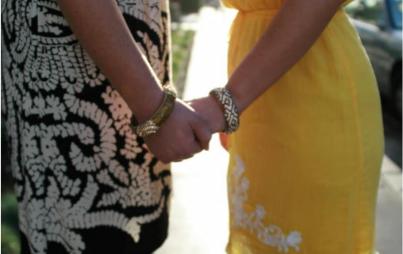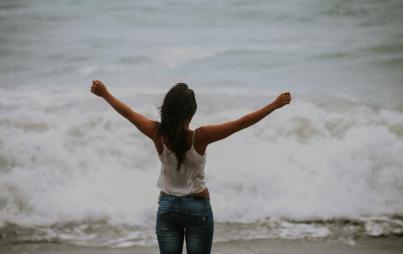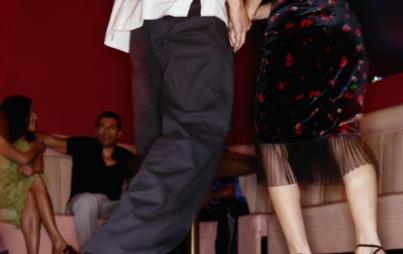
So many times in life, Daisy grew through the cracks, through what seemed like impossible obstacles.
I knew before I truly knew. When the icon revealing the new Facebook message from Daisy’s brother flashed on my screen on a hot July evening in 2017, my heart fell to my feet. He and I had been in touch a handful of times during the 19 years his sister and I had been friends, but it was rare when there was good news. I paused, hovering over the message, simultaneously wanting to hold onto the moment of not knowing, yet eager to move past it as quickly as I could. He asked me to call him, gave me his number and wrote, “There’s no good way to tell you this. I’m sorry to say my sister has passed away.” Immediately, I knew that the cause of her death had been suicide. I stared at words on the screen not quite knowing how to receive the news. Inhaling deeply, I picked up my phone and dialed.
Daisy and I met through an online women’s group in 1998 long before connecting with new people meant logging into Facebook, Instagram or Twitter. In my early twenties, while very sick with Lyme disease and related complications, I had been homebound for the better part of the 1990s. I spent my days sleeping and my nights writing — especially letters — because I was hungry for connections that were impossible to manifest any other way. It was challenging to have a social life when I felt too sick to do more than survive whatever each day brought.
I struggled to wrap my head around how illness placed me in the position of having to defend what was true. It was the first time I realized that sexism could have serious, real-life implications. Illness felt like a burden, but so did being female in a world that doesn’t always know how to accept female bodies as they are.
I didn’t have a computer of my own until after the year 2001. My dad had purchased a computer for the family in 1994 just before the technology that would allow Internet access was becoming widely available. He was resolute that he wasn’t buying another computer. After all, he reasoned, they would just change the technology all over again, and it would be a waste of money. I understood his point, but I also yearned to connect with the outside world and saw the Internet as a means of doing so. No one fully understood then how deeply ingrained the internet would become in all of our lives.
My father and I made a compromise: he would let me borrow his work laptop every night after he got home from work and I would have it ready and waiting for him in his black computer bag every morning. When he came through the door, I eyed his hands and greeted him by asking, “Did you bring the computer?”
I needed what the internet gave me: a life beyond only feeling physically horrible and emotionally alone so much of the time.
The presence of my illness dominated my household and often caused a lot of tension. I had been a model daughter and straight A-student up until the time I got sick when I was 14 and had to leave school. Suddenly, I had to fight to be believed by family members who didn’t understand why I wasn’t getting well and I had to fight to get doctors to realize that I was capable of accurately reporting my symptoms. I struggled to wrap my head around how illness placed me in the position of having to defend what was true. It was the first time I realized that sexism could have serious, real-life implications. Illness felt like a burden, but so did being female in a world that doesn’t always know how to accept female bodies as they are.
Daisy understood this. Her natural gift of empathy remained unrivaled. She instantly could take in someone else’s sorrow, speak it aloud back in clear and concise terms, shake her head at the injustices in the world, and offer a space of solace and comfort. Even if the issue was something that she couldn’t personally relate to, she drew on her own experiences and reminded about the power of resilience. She had both physical and mental health issues that were misdiagnosed for years. Suffering was not an alien concept to her.
Daisy wasn’t her real name; I was one of only five people who called her that on a regular basis. It was a nickname she chose because “daisies grow through cracks in the sidewalk.” Daisies, she always said, are strong and can thrive under any circumstances. It was perfect for her.
The online women’s group where we met was started by a chronically ill woman named Alisun who signed all of her handwritten notes with little rays of light streaming forth from the “sun” part of her name. She called the group the “gardyn.” We communicated via email. The details are a little fuzzy on how Daisy and Alisun first met, but everyone in the group had some connection to Alisun and each of us lived with chronic health challenges.
One day not long after the gardyn began, Alisun suggested that we all choose flowers that reflected something about ourselves. She chose “AliSunLily.” The Pittsburgh born and bred “Sunny” selected sunflowers because she wanted more positivity in her life. The whip-smart redheaded “Snap” chose snapdragons and divided her time between Boston and Washington, D.C., warning us never to move to a new city because of a boyfriend unless we really wanted to live there. “Karrot," who hailed from Alaska, hunted, fished, knew an endless amount about herbal medicine, played the guitar, and had a stunningly beautiful singing voice.
When it was my turn to pick, I thought and thought about it. Just as dawn was breaking, I stepped outside onto my parents’ back porch in a semi-rural town in suburban Philadelphia and saw the mist rising above the ground in the meadow that borders their property. I walked closer to the open space that was filled with thick natural greenery. A canopy of trees that served as a dividing line between “ours” and “not ours” obscured the sky. Birds high up in the trees were in conversation with each other. My eyes focused on the land and I noticed small yellow flowers that had sprung up seemingly out of nowhere. I knew then what my chosen nickname would be: Wildflower.
I understood at that moment how important it was to bloom wherever you were planted but to keep a tiny bit of wildness and freedom in your spirit even if other forces limited you.
I was trying. I went back inside, wrote a quick email to the group, packed up my dad’s computer for him to take to work and promptly fell Into a contented sleep — a rarity for me. I could feel myself growing already.
The gardyn felt like a “safe space” nearly two decades before that term would become common usage in the cultural lexicon. We could talk about anything — health, women’s issues, history, books, activism, politics, films, and music. The conversations often transpired so quickly that I had a hard time keeping up with the email threads. We were all writers, so no one was at a loss for words. Ever. Everyone else had a much more formal education than I had. I grew up reading poetry aloud to my parents every night after dinner, but had never heard of Sylvia Plath, Alice Walker, Rita Dove, or Anne Sexton, four writers whose work Daisy introduced me to.
I didn’t know what the patriarchy was, though I had felt its sharp effects slicing through the spots in my body, mind, and spirit. I knew how it felt to be powerless — and to feel ashamed, angry and frozen when that emotion bubbled to the surface, like when the neurologist I consulted at age 14 kept complimenting me in detail on the style of underpants I was wearing (plain pink Hanes my mom bought at K-Mart). Daisy and the other women in the gardyn understood the anger I had pushed down inside as a means of coping with not having my voice heard when seeking medical care. They all had experienced it in various forms too — the pain of being sick and not being believed or understood evoked a kind of wound that I was unprepared to handle in my young teens.
Until I crossed paths with the women in the gardyn, I didn’t have the formal language to explain a lot of what I had experienced or to realize the extent to which other women had gone through similar things.
Like a sponge, I soaked up my new found knowledge about women’s issues, quickly searching on Yahoo or AltaVista, the pre-Google-era search engines, to get up to speed. I loved learning and savored being surrounded by people who treated me as an equal in the adult realm. In the thousands of messages that went back and forth, disagreements arose on occasion, but I can’t ever recall someone being blatantly disrespectful to someone else. We were there to support one another. Being female gave us a particular orientation in the world. Connecting with other women in their twenties, all of whom were finding their way, too meant something to each of us.
It would take many years, but it was only by tapping into my own power that I could make peace with growing up in a world that was not always accepting or welcoming and sometimes could be hostile to those who identify as women. I found ways of acknowledging the reality without letting it destroy me. Daisy once wrote to me, “Wildflower, never give anyone the luxury of defining you.” It became a mantra. Until then, I didn’t realize that I could define myself, but once I discovered it, the real work began.
Daisy and I were the youngest in the gardyn, only a year apart. Her last name was also a name in my family lineage. We wondered if we were distantly related, though no confirmation of that was ever found. Her given first name was the one I lied and told people was mine when I five years old. There were so many idiosyncratic synchronicities that popped up in the group that Lily coined the term, “sisternicitiy!” It always had an exclamation point after it.
You Might Also Like: How To Talk To Your Kids About Suicide
Daisy often spoke of returning to college to finish her degree. She applied and was accepted to Smith College, but wasn’t able to go because of her health. It was a lost dream she never quite reconciled. Because it wasn’t possible for me to go to school during the “typical” college years of 18 to 22, I thought that I forever had missed my chance. I didn’t realize that people could enroll in an undergraduate program at any age. I hadn’t known anyone else who went to school later in life and finished.
Wanting a career that reflected her values, Daisy considered becoming a social worker. She wanted to help people by offering them the help that she so often fought for, but never fully received. She wrote with such clarity and intelligence that it was surprising and confusing when hints of her mental illness began to seep into her messages.
About four years after the gardyn began, we all received an email that could only be considered unusual, given our regular, ongoing correspondence. Daisy wrote a rambling message in which she referred to herself in the third person using the childhood version of her given name. She wrote about how she was upset. Life wasn’t fair, and no one loved her, she said. Her language was that of a kindergartener. I had no idea how to respond, nor did the other women. Intuitively knowing that she was in trouble in a way that was way beyond what I could help her with, I did the second best thing that I could. I wrote to her as simply and compassionately as I could and addressed her as if she were that young child. Regardless of whatever part of her mind was taking her into these murky waters, I knew that her spirit required comfort and tenderness.
I didn’t know how to help her, but I wanted to make sure that she knew she was being heard and responded to.
She had been diagnosed with clinical depression. But, it became increasingly obvious that something else was happening on a deeper level. Even though the gardyn members were close to each other, not being in a single geographical location meant that some pieces of information about our lives could be obscured, intentionally or not. It is easy to empathize in theory, but far harder to do so in practice. The issues that arose required each of us to step up in our own ways for each other at different times.
When I experienced a violent crime in the summer of 2004, Sunny told me that she was getting in her car and coming to see me. She lived over six hours away. When I told her that I wasn’t up for having fun, she replied that that was fine — that we would sit on my couch and watch old Hitchcock movies. She said that I could cry as much as I wanted to; she wouldn’t mind. So that’s what we did. Sunny was a great cook and was determined to help me become a better one. I was the only one impressed by the fact that I had mastered boiling water for pasta. She taught me how to make perfect roasted potatoes. Golden drizzles of olive oil and the scent of fresh rosemary connected me to the tangible world — a world trauma wasn’t allowing me to live in fully. I was allowed to be imperfect, to feel imperfect and to simply be.
My imperfection, though, ultimately played a role at the end of our friendship a year and a half later when I was not able to reciprocate being there for Sunny. It’s something that I feel regret about to this day. When her mother died in the middle of January after a long illness, Sunny wanted me to borrow a car and drive six hours in snowy, icy weather to attend the funeral. I had gotten my driver’s license three weeks before, didn’t have a car, and was afraid to undertake the journey alone. When I explained the challenges, she said it was okay.
When she was the person I knew, she was witty and smart and compassionate. When her illness took over, it was like looking into a tempest of chaos.
Later, I found out it hadn’t been okay. Our friendship went on for a few strained months after that but ended within the year. Friendships that begin online and transition offline sometimes carry with them a unique imprint-- the expectation that one will be able to live up to the level of giving in “real life” that seems so easy from behind a screen.
Snap and Daisy experienced something similar. For reasons that are unclear now — that were never quite completely clear, to begin with — Daisy was on the verge of ending up homeless. Snap lived several states away, but her ex-boyfriend had an apartment near where Daisy was living. She convinced him to let Daisy live there rent-free. She stayed for three years.
Despite having a place to stay and some medical care, her correct diagnosis of schizophrenia didn’t happen soon enough to save her from stepping out of the tangible world into a realm that only she saw and understood. When she was the person I knew, she was witty and smart and compassionate. When her illness took over, it was like looking into a tempest of chaos.
Over time, her erratic behavior over which she had no control alienated people who cared about her. It was crushing to see how alone she felt. I reminded her that she wasn’t alone, but she never fully believed it. I felt very helpless. It is difficult — impossible — to convince someone they are cared about when their mental illness fights you at every turn to prevent them from believing it.
When things got really bad, Daisy ended up hospitalized. Those hospitalizations were difficult for her but necessary — they saved her life. But, she often told of how some of the doctors who treated her had difficulty understanding that a person could have both a physical illness and a mental one; she had both. Daisy’s health battles were complex, but her desire to be heard, believed and understood was simple and crystal clear.
She was on fire when she talked about wanting to do something to help women’s concerns be taken seriously in healthcare — long before the kinds of cultural conversations we have now much more openly.
Daisy was a flower who bloomed far ahead of her time. In 2003, she wrote an email and shared it with the gardyn. Annoyed with how sexual assault prevention tips always focused on what the victim should do differently, she wrote a scathing list of tips of her own. Each tip turned conventional “advice” upside down. They included things like, “If you are thinking of raping someone, don’t” and “Carry a whistle with you. If you are about to rape someone, blow it so that someone will stop you.” Classic Daisy. She sent the list out via email. It went viral. It ended up being attributed to other people and adapted over the years, but she was the original author.
Even after her correct diagnosis, while living in the south in 2005, Daisy stole her mother’s car and drove it across a bridge. Voices in her head told her to crash the car into the guardrail at 80 MPH. Paramedics cut off her gasoline-soaked clothing while in the ambulance. She lied and said she had no health insurance because she didn’t want to be put into a psych ward. Her mother and brother confirmed that it definitely had been a suicide attempt and warned that she should not be sent home. But, she was. The hospital put her in a cab wearing random, found clothing several sizes too big and sent her on her way.
She wrote, “Looking back on that day now, what I remember most is absolute terror. Terrorized by my own mind, I was in an unreal world, thinking delusional thoughts and feeling totally alone in the universe.”
Suicide always lingered in the backdrop of Daisy’s life, no matter how many times she tried to outrun it.
She believed in gun control, yet at one point the voices in her head told her to purchase a weapon. She methodically researched what kind of gun would do its horrific task and not impact anyone else with a stray bullet. Even while she actively was planning to kill herself, she was thinking about others.
She wrote, “I got advice from guys on the internet as to what would be the best gun to make sure a person died. I was clear that this person was myself.”
She was upset by how easy it was to buy a gun in her mental state even as she did it. She fought the voices and delusions on a daily basis, and for a long time, she won, even when winning meant being hospitalized temporarily.
Through therapy, medication and sheer grit, Daisy managed to have a period of relative stability. Daisy was the one who inspired me to return to school as an adult and nearly 20 years after first meeting; we were both students in the home stretch of our Bachelor’s degrees at the same time. It looked like we were going to graduate during the same semester many miles away from each other.
But, the voices in her mind had other plans. One class away from graduation, she had to take a medical leave of absence. I went on to finish my degree, even though it required me hobbling on a broken hip (an injury I sustained during my final semesters), nearly falling down in the street and needing a dear classmate to walk me between classes to do it.
No achievement was earned easily — daisies and wildflowers must fight their way towards the sun through all kinds of terrain.
Daisy understood this profoundly and often sent me snail mail letters of encouragement and support for no reason.
She continued her advocacy efforts and routinely volunteered for NAMI and spoke to community groups, students, mental health professionals, and law enforcement officials about mental health issues and how to help those in need. Her generosity of spirit towards serving others was an integral part of who she was — so much so that she didn’t even recognize that it was an extraordinary quality.
From 2015 to 2017, Daisy’s struggles took on a new shape. There was a level of hopelessness and negativity that seemed different from years past. She disliked where she was living — in an apartment building for veterans where she was the only woman. The circumstances around her home made her feel unsafe. She had little money, and that was a constant worry, as was her health. Her cats provided her greatest solace. On the days when she was too sick or too depressed to get out of bed or off of her couch, they cuddled up beside her.
The gardyn had long since disbanded. Daisy and I had remained good friends, but in the months leading up to her death, we weren’t in touch as much. I was struggling with my own life, and I didn’t know how to process someone else’s challenges that were so much larger than what I could handle.
I never held the illusion that I could fix or heal Daisy; I didn’t try.
So often, people tried to “fix” me when I was so sick as a teen. Their intentions were coming from the right place, but the execution often was very misguided. Daisy had experienced the same. She knew how dehumanizing it could be, so we respected each other’s space and accepted whatever was, offering only encouragement.
I later found out that in the months leading up to her death, Daisy broke ties with almost everyone close to her. The voices had gotten stronger. On a hot summer day, she packed a bag and headed for the airport. She purchased a ticket for a flight to Chicago that she would never board. She checked her bag with the airline and then, checked into a hotel near the airport. Soon after, she inexplicably embarked on a journey alone that she could never return from.
After her death, I wondered if I could have done more for her — been a better friend somehow — a friend powerful enough to keep her alive. But, I also knew that it was a foolish thought.
I took comfort in doing precisely what Daisy would have told me to do, which was recalling my own humanness — that each of us is doing the best we can every day.
I choose not to remember her by the circumstances of her death, but by how she lived her life.
Her brother gave the eulogy at her funeral, and since I couldn’t attend, he sent it to me. In it, he shared something she had written to him two years before:
My story is really a story of perseverance. Someone once said, ‘The world is full of suffering, but it also full of the overcoming of it.’ I have overcome a lot, and at times like now, it is hard to believe I can overcome any more, but handling more is what life consists of.
When I look back on my life, I need to remember that there has been more to it than difficulties, that there has been happiness, and that there have even been some triumphs. Even the little triumphs count.
I read a meditation I liked, and it said I need to remember to value the simple chores of life. Things that take us back to the rhythm and the way of life we're after. When we don't want to be bothered with the laundry, bills or dishes, when we have other things to think about, or more important tasks to accomplish on this journey we're on we get overwhelmed, but doing ordinary tasks doesn't take us away from the rhythm we're seeking. They don't take us away from life's magic. The simple tasks are important, not just because they need to be done. The simple tasks are the microcosm of how our lives work. They keep us grounded in reality; they remind us what's real, they will lead us into the life we're seeking if we do these tasks with respect. If you restore and maintain order around, you will feel order in your soul. Create beauty around you, and you'll feel beauty in your soul. The magic will return. The simple tasks will lead you back in.
So many times in life, Daisy grew through the cracks, through what seemed like impossible obstacles. And yet, she never stopped blooming or sharing her beauty with the world. A few weeks after her death, I bought some daisy seeds to scatter around. The world, it seems, could always use more daisies.








